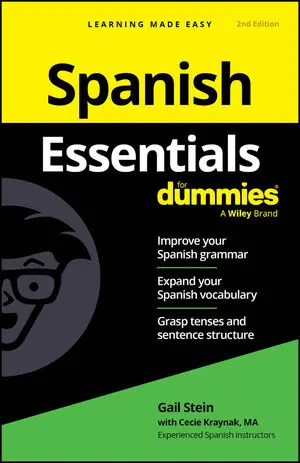Articles & Books From Language & Language Arts
Turn your ideas into graphic novels with this step-by-step guide—including drawing exercises Writing Graphic Novels For Dummies walks you through the process of graphic novel creation step-by-step, guiding you through the process of developing ideas, concepts, and visuals to bring your unique stories to life.
An essential guide for Italian language learnersItalian Essentials For Dummies walks you through the foundations and essentials of introductory Italian. It covers Italian grammar, vocabulary, pronunciation, verb forms and tenses, and more, demonstrating exactly what you need to know to quickly get up to speed on the basics.
The Dummies language learning method makes it easy to speak Italiano Italian For Dummies is your quick-start guide to the Italian language. It offers friendly and clear instruction on Italian grammar and pronunciation, and even some cultural background to spice things up. You'll also get ample practice opportunities, so you can quickly build your skill in conversational Italian.
Cheat Sheet / Updated 11-03-2025
Do you have Greek heritage? Is your partner Greek? Are you visiting Greece for vacation? With this Cheat Sheet, you can make a strong start in learning the Greek language. Here you find common Greek greetings, expressions, questions, and other handy phrases to use in different situations. Common Greek greetings and expressions Imagine you just arrived in Greece and you're sitting at a café.
Everything you need to speak Greek quickly and confidently Modern Greek For Dummies teaches you everything you need to start speaking Greek. This friendly guide provides clear explanations of grammar and authentic phrases and dialogues, so you can start communicating in Greek-speaking communities right away. Examples and exercises help you work your way through the alphabet and basic constructions, toward conversational fluency.
Cheat Sheet / Updated 11-03-2025
Planning a trip to Italy? Learn some basic Italian to make it more fulfilling. Get to know Italian greetings, question words, numbers, and the days of the week. Also, be sure to know how to ask for help in Italian so you're prepared for emergencies. And something very important: how to order food and drinks! This Cheat Sheet includes some useful phrases you can use every day as well as some phrases for dealing with an emergency and ordering food and drink.
An easy-to-follow and hands-on guide for German learners new to the language and for anyone seeking to brush up on the fundamentals German Essentials For Dummies, 2nd Edition is a quick, concise, and straightforward guide to conversational German. Perfect for anyone who wants to jumpstart their understanding of German, the book is packed with examples, definitions, and handy tips you can start using immediately.
Get right to the good stuff with this easy-to-follow guide to French fundamentals French Essentials For Dummies, 2nd Edition walks you through the core concepts of French so you can apply right away and start communicating effectively. From conjugating verbs to understanding tenses, this easy-to-read guide skips past the fluff and dives deep into the basics you need to improve your French and succeed on a French class exam and more.
The perfect guide for new Spanish learners and anyone looking for an expert refresher Interested in a fast and effective guide to learning Spanish that avoids fluff and focuses on key concepts that you need to know to improve your ability to speak, write, and understand the language? Spanish Essentials For Dummies, 2nd Edition walks you through Spanish fundamentals you can use for at-home, solo learning, to supplement your progress in a Spanish class, or as a companion to language instruction.
Cheat Sheet / Updated 04-21-2025
Speaking Spanish requires you to keep tabs on all sorts of topics: essential words and phrases, basic Spanish questions, and the proper gender of articles. Plus, if you intend to travel, you want to be able to get help and give warnings in the case of an emergency.Refer to this Cheat Sheet for your Spanish essentials.









